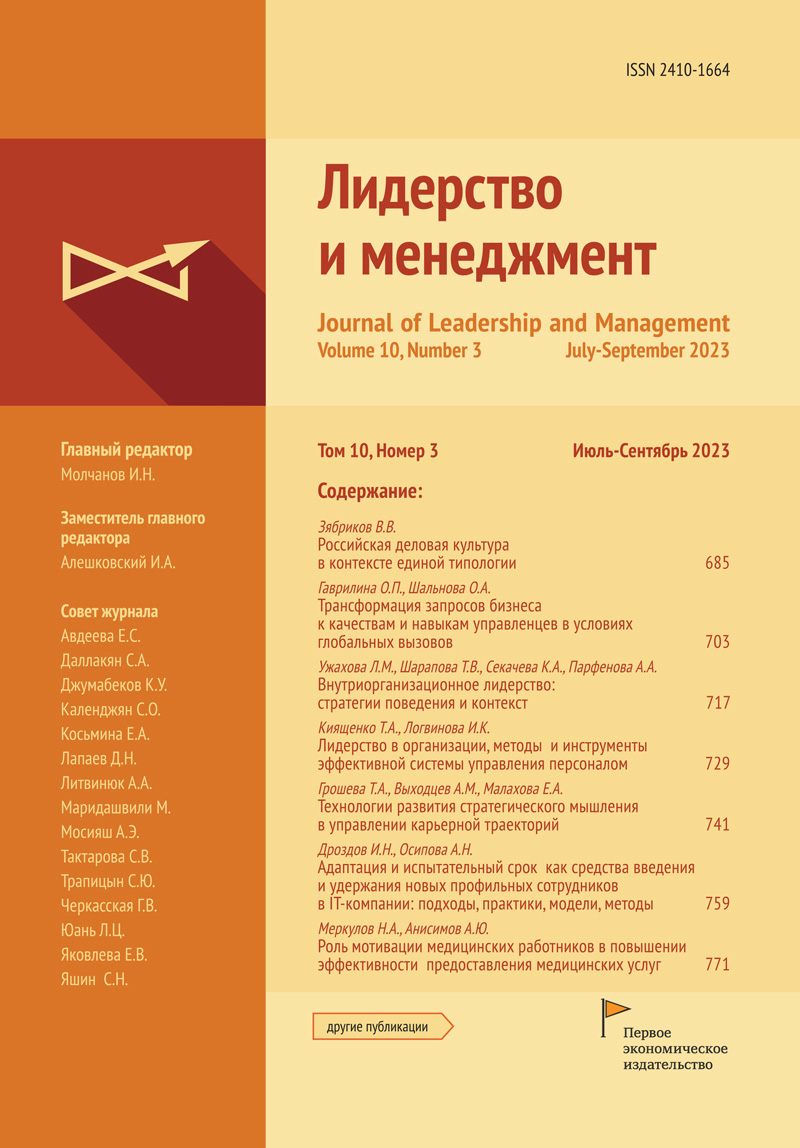Leadership in the organization: methods and tools of an effective personnel management system
- Авторлар: Kiyashchenko T.A.1, Logvinova I.K.1
-
Мекемелер:
- Rostov State Transport University
- Шығарылым: Том 10, № 3 (2023)
- Беттер: 729-740
- Бөлім: Articles
- URL: https://journals.eco-vector.com/2410-1664/article/view/607951
- DOI: https://doi.org/10.18334/lim.10.3.117967
- ID: 607951
Дәйексөз келтіру
Аннотация
The article is devoted to the formation of a managerial style based on leadership qualities, application of methods and tools for the development of personal management effectiveness. The algorithms of managerial activity are considered. The Cycle of Managerial Functions technology is proposed. In this technology, each personal management function is analyzed and described in detail, taking into account the individual characteristics of employees as a leader's tool in management. The prism of the concepts of administrative resource and leadership resource is considered. The authors try to answer the following questions. How to recognize a motivated employee by verbal signs and determine the true structure of his needs? Based on observations, how can a manager competently choose behavior for different motivational needs?
Негізгі сөздер
Авторлар туралы
Tatiana Kiyashchenko
Rostov State Transport University
Email: Syxorykovataina@mail.ru
Irina Logvinova
Rostov State Transport University
Email: logvinovaik@mail.ru
Әдебиет тізімі
- Губанова А.В., Минева О.К. Исследование стилей руководства и способностей к трансформационному лидерству современных российских лидеров // Лидерство и менеджмент. – 2022. – № 3. – c. 639-656. – doi: 10.18334/lim.9.3.116151.
- Грязева-Добшинская В.Г., Дмитриева Ю.А., Маркина Н.В. Трансформационное лидерство и стратегические управленческие установки менеджеров // Вестник Московского государственного областного университета. – 2018. – № 3. – c. 111-133.
- Евтихов О.В. Особенности формирования лидерского образа руководителя как организационного лидера // Лидерство и менеджмент. – 2017. – № 3. – c. 117-122. – doi: 10.18334/lim.4.3.38272.
- Комаров В.В. Организационное лидерство: подходы к определению и классификации стилей лидерства // Лидерство и менеджмент. – 2022. – № 2. – c. 439-460. – doi: 10.18334/lim.9.2.114367.
- Лаптева Е.В., Попов А.А. К вопросу о лидерстве и оценке лидерских качеств // Лидерство и менеджмент. – 2022. – № 1. – c. 23-36. – doi: 10.18334/lim.9.1.114291.
- Лапидус Е. И. Оценка и развитие креативности и инновационности как компетенций управленческих кадров / // Научное мнение. – 2020. – № 9. – c. 30-39.
- Маслоу А. Мотивация и личность. - К. : PSYLIB, 2004.
- Ригин А.А., Елин А.М. Понимание аспектов лидерства в структуре управления организацией // Экономика, предпринимательство и право. – 2021. – № 11. – c. 2623-2636. – doi: 10.18334/epp.11.11.113814.
- Снегирев В.А. Кадровое обеспечение: инструменты стимулирования и воздействия на работников разных возрастных групп // Экономика труда. – 2020. – № 4. – c. 347-364. – doi: 10.18334/et.7.4.100876.
- Титова С.В. Индивидуальный план развития сотрудника – результативный способ управления карьерой в организации // Инновационная экономика: перспективы развития и совершенствования. – 2021. – № 1(51). – c. 333-337.
- Hackman J.R., Oldham G.R. Motivation through the design of work: Test of a theory // Organizational behavior and human performance. – 1976. – № 2. – p. 250-276. – doi: 10.1016/0030-5073(76)90016-7.
Қосымша файлдар








